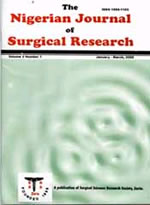
|
Nigerian Journal of Surgical Research
Surgical Sciences Research Society, Zaria and Association of Surgeons of Nigeria
ISSN: 1595-1103
Vol. 8, No. 1-2, 2006, pp. 62-64
|
 Bioline Code: sr06011
Bioline Code: sr06011
Full paper language: English
Document type: Research Article
Document available free of charge
|
|
|
Nigerian Journal of Surgical Research, Vol. 8, No. 1-2, 2006, pp. 62-64
| en |
Hirschsprung’s disease presenting in the neonatal period in Jos,Nigeria
Chirdan, L. B. & Uba, A.F.
Abstract
Background:
While most cases of Hirschsprung’s disease are diagnosed during the neonatal period in developed countries, majority of the cases present outside the neonatal period in developing countries. We reviewed our experience with Hirschsprung’s disease presenting during the neonatal period to document the presentation and management.
Patients/Methods:
A retrospective analysis of the presentation and management of 31 neonates with Hirschsprung’s disease over a nine year period in a Tertiary pediatric surgical centre in Nigeria was performed.
Results:
From January 1996 – December 2004, 78 children were managed for Hirschsprung’s disease in our unit. Thirty-one (39.7%) were aged 30 days or below. The median age at presentation was eight days (range 2-30 days). There were 23 boys and 8 girls. The median weight at presentation was 2.8kg (range 2.3 – 4.5kg). Fifteen weighed <2.5kg. Twenty-two presented with acute intestinal obstruction. Three presented with enterocolitis while in five there was delayed passage of meconium and recurrent constipation. Barium enema was done in 25 and rectal biopsy confirmed diagnosis in 29 babies. In two babies with total colonic aganglionosis (TCA), diagnosis was confirmed by colonic biopsy at laparotomy. Twenty nine had right transverse loop colostomy in the neonatal period; four were under local anesthesia, while the two children with TCA had ileostomy. Four children died before definitive surgery, two with TCA and two with enterocolitis. None had primary pull-through. Two children were lost to follow up after colostomy formation. Twenty two had definitive surgery between the ages of three months and five years. Fifteen had Boley’s endorectal pull-through with a single mortality; while seven had Swenson’s pull-through, one of whom died.
Conclusion:
Few cases of Hirschsprung’s disease present during the neonatal period in our environment, many presenting with intestinal obstruction. A high index of suspicion is needed for the early diagnosis of Hirschsprung’s disease in environment with limited diagnostic facilities.
Keywords
Hirschsprung’s disease, neonate, intestinal obstruction.
|
| |
© Copyright 2006 - Nigerian Journal of Surgical Research
|
|
